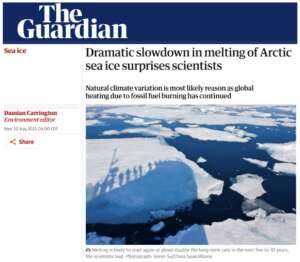Scientific literature casting doubt on the size of any climate change crisis is usually ignored by the media. So it’s a rare news event when The Guardian, easily the most left-wing of all British papers, reports that the melting sea ice in the Arctic Ocean has slowed dramatically in the past 20 years.
Dr Mark England, who led the study while at the University of Exeter, reports there has been no statistically significant decline since 2005:
“The good news is that 10 to 15 years ago when sea ice loss was accelerating, some people were talking about an ice-free Arctic before 2020. But now the natural variability has switched to largely cancelling out sea ice loss.”
England finds the finding “surprising” because carbon emissions from fossil fuels have continued to rise and trap ever more heat over that time. He attributes the change to long-term fluctuations in currents in the Atlantic and Pacific Oceans, which change the amount of warmed water flowing into the Arctic.
Of course, natural variation means that melting may again increase at some point in the next five to 10 years. But the study is one of several that show how the most alarmist climate studies get most of the media coverage.
Earlier this year, a paper published in Nature Communications found that ice has remained stable and even grown slightly since the 1930s over a 1,200 mile stretch of Eastern Antarctica. Another recent paper found the ice shelves surrounding Antarctica grew in overall size from 2009 to 2019.
The fact that you have read almost nothing about any of these studies should tell you all you need to know about climate change coverage in the mainstream media.

